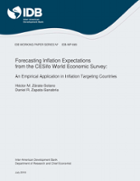Forecasting Inflation Expectations from the CESifo World Economic Survey: An Empirical Application in Inflation Targeting
Date
Jul 2018
The purpose of this paper is twofold. First, we evaluate the responses to the questions on inflation expectations in the World Economic Survey for sixteen inflation targeting countries. Second, we compare inflation expectation forecasts across countries by using a two-step approach that selects the most accurate linear or non-linear forecasting method for each country. Then, using Self Organizing Maps, we cluster the inflation expectations, setting June 2014 as a benchmark. At this time there was a sharp decline in oil prices and by analyzing inflation expectations in the context of this price change, we can discriminate between countries that anticipated the oil shock smoothly and those that had to significantly adjust their expectations. Our main findings from the in-sample comparison of the WES surveys suggest that expert forecasts of inflation expectations are systematically distorted in 83 percent of the countries in the sample. On the other hand, our out of sample forecast analysis indicates that Non-linear Artificial Neural Networks combined with Bayesian regularization outperform ARIMA linear models for longer forecasting horizons. This holds true for countries with both soft and brisk changes of expectations. However, when forecasting one step ahead, the performance between the two methods is similar.




